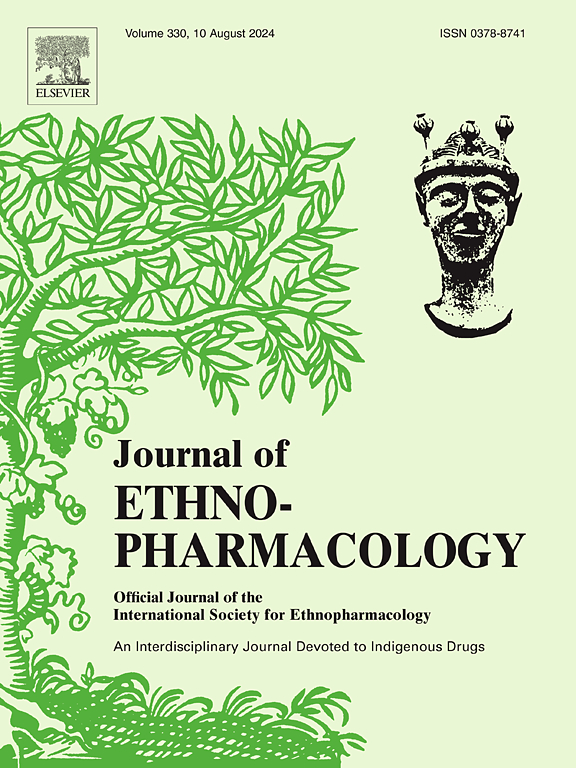Comparative studies on the components and anti-ulcerative colitis effects of raw and carbonized Linderae Radix
IF 5.4
2区 医学
Q1 CHEMISTRY, MEDICINAL
引用次数: 0
Abstract
Ethnopharmacological relevance
Linderae Radix (LR) is a traditional Chinese medicine widely used in the clinical treatment of ulcerative colitis (UC). Carbonized Linderae Radix (CLR) is produced by stir-frying of LR. However, the effects of carbonization on its chemical composition and therapeutic efficacy in UC remain unclear.
Aim of the study
To compare the chemical composition and therapeutic effects of LR and CLR in dextran sulfate sodium (DSS)-induced UC.
Materials and methods
The chemical profiles of LR and CLR were analyzed by UPLC-Triple-TOF/MS. A 2.5 % DSS-induced UC mouse model was used to assess treatment efficacy. Disease indicators such as DAI scores, colon length, and spleen index were evaluated. Histopathology, AB-PAS staining, immunohistochemistry, and immunofluorescence were employed to assess epithelial integrity, mucus barrier, proliferation, and intestinal stem cells (ISCs). Network pharmacology was performed to explore underlying mechanisms. The above results were verified using molecular docking.
Results
Carbonization significantly altered LR's chemical profile, with the loss of bioactive compounds such as Linderalactone and Norisoboldine, and the emergence of new constituents like Ethyl caffeate. Both LR and CLR improved UC symptoms, preserved tight junctions, protected ISCs, and promoted epithelial proliferation. LR more effectively reduced histological damage and maintained crypt structure and goblet cells. CLR showed superior effects on mucus barrier restoration by upregulating MUC2 expression. Network analysis revealed that CLR targets were mainly enriched in inflammation- and apoptosis-related pathways (MAPK, PI3K-Akt, IL-17), while LR was enriched in regenerative and stemness-related pathways (Wnt, Notch, and JAK-STAT).
Conclusion
Carbonization alters the chemical composition and therapeutic focus of LR. LR primarily enhances mucosal regeneration and ISCs activity, while CLR improves the mucus barrier and modulates inflammatory responses.

生枸杞与炭化枸杞成分及抗溃疡性结肠炎作用的比较研究。
民族药理学相关性:林芝(Linderae Radix, LR)是一种广泛应用于临床治疗溃疡性结肠炎(UC)的中药。炭化林芝(CLR)是用林芝炒制的。然而,碳化对其化学成分和UC治疗效果的影响尚不清楚。目的:比较右旋糖酐硫酸钠(DSS)诱导UC的LR和CLR的化学成分和治疗效果。材料与方法:采用UPLC-Triple-TOF/MS分析了LR和CLR的化学特征。采用2.5% dss诱导UC小鼠模型评价治疗效果。评估疾病指标,如DAI评分、结肠长度和脾脏指数。采用组织病理学、AB-PAS染色、免疫组织化学和免疫荧光来评估上皮完整性、粘液屏障、增殖和肠干细胞(ISCs)。采用网络药理学方法探讨其潜在机制。利用分子对接对上述结果进行了验证。结果:碳化显著改变了LR的化学特征,失去了生物活性化合物,如林得拉内酯和去甲异波定,并出现了新的成分,如咖啡酸乙酯。LR和CLR均可改善UC症状,保留紧密连接,保护ISCs并促进上皮细胞增殖。LR更有效地减少组织损伤,维持隐窝结构和杯状细胞。CLR通过上调MUC2的表达对黏液屏障的恢复有较好的作用。网络分析显示,CLR靶点主要富集于炎症和凋亡相关通路(MAPK、PI3K-Akt、IL-17),而LR则富集于再生和干细胞相关通路(Wnt、Notch和JAK-STAT)。结论:碳化改变了LR的化学成分和治疗重点。LR主要促进粘膜再生和ISCs活性,而CLR改善粘液屏障并调节炎症反应。
本文章由计算机程序翻译,如有差异,请以英文原文为准。
求助全文
约1分钟内获得全文
求助全文
来源期刊

Journal of ethnopharmacology
医学-全科医学与补充医学
CiteScore
10.30
自引率
5.60%
发文量
967
审稿时长
77 days
期刊介绍:
The Journal of Ethnopharmacology is dedicated to the exchange of information and understandings about people''s use of plants, fungi, animals, microorganisms and minerals and their biological and pharmacological effects based on the principles established through international conventions. Early people confronted with illness and disease, discovered a wealth of useful therapeutic agents in the plant and animal kingdoms. The empirical knowledge of these medicinal substances and their toxic potential was passed on by oral tradition and sometimes recorded in herbals and other texts on materia medica. Many valuable drugs of today (e.g., atropine, ephedrine, tubocurarine, digoxin, reserpine) came into use through the study of indigenous remedies. Chemists continue to use plant-derived drugs (e.g., morphine, taxol, physostigmine, quinidine, emetine) as prototypes in their attempts to develop more effective and less toxic medicinals.
 求助内容:
求助内容: 应助结果提醒方式:
应助结果提醒方式:


